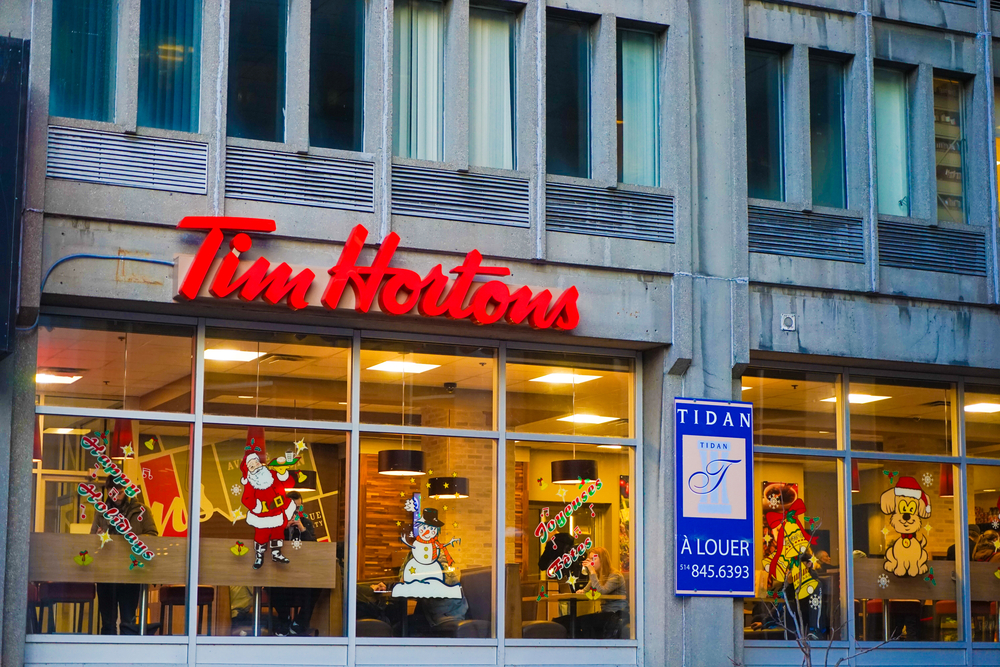Business and Economy
Tim Hortons bets future growth on trends and innovation in competitive market

For Tim Hortons, that has included new breakfast sandwiches and burgers featuring Beyond Meat patties, remodelled restaurants, a new loyalty program, and a new cafe at its head office to test out potential offerings.
(Shutterstock Photo)
TORONTO — Shares in Restaurant Brands International Inc.
soared Friday as the company reported strong second-quarter earnings that widely exceeded analysts’ expectations.
The parent company of Tim Hortons says its rapid adoption of new tastes and technologies is helping drive sales growth across its more than 26,000 restaurants globally.
Restaurant Brands International Inc., which is also behind Burger King and Popeyes, has been busy adding plant-based protein menu items and options like digital kiosks, delivery and apps to attract customers in the competitive fast-food industry.
For Tim Hortons, that has included new breakfast sandwiches and burgers featuring Beyond Meat patties, remodelled restaurants, a new loyalty program, and a new cafe at its head office to test out potential offerings.
“Our vision for innovation with Tim Hortons, in particular in Canada, has been to listen to our guests and bring what we’re calling on-trend innovation,” said Tim Hortons president Alex Macedo.
The efforts have helped increase sales, though growth at Tim Hortons has lagged the company’s other brands.
Tim Hortons comparable sales were up 0.5 per cent in the last quarter compared with flat sales last year, while Burger King, where the company announced Thursday it was rolling out the plant-based Impossible Whopper nationally in the U.S., saw comparable sales up 3.6 per cent and Popeyes up three per cent.
The company says it’s still in the midst of a refresh for Tim Hortons, where it remodelled 400 restaurants last year with aims to do the same this year, and has plans for “super urban” shops for major cities like Toronto and Vancouver.
The loyalty program Tims has rolled out will also give it unprecedented ways to see how its new products and designs are working, said Macedo.
“The true beauty of the program?is learning about their habits, understanding when they come, why they come, and trying to make their experience better,” he said in an interview.
“We have an infinite amount of data that we’re collecting, and I think over the next mid to long run this will materially change the way we relate to our guests.”
Roughly seven million Canadians have already signed up for the program, while about half of its customers are either swiping their card or using the app for purchases, said Macedo.
The wide variety of changes pose challenges for the franchisees, who have pushed back on orders from above in the past, but Macedo said the changes are going well since many owners manage only one or two restaurants.
“It’s a lot, but we’ve been able to roll this out because of the quality of our restaurant owners, and it’s been very productive for the business.”
Overall, Restaurant Brands saw system-wide sale growth of 7.9 per cent in the quarter ending June 30, helped by the 1,245 more restaurants it had in the second quarter than the same period last year.
The company, which reports in US dollars, said total revenue for the quarter came in at $1.4 billion, up from $1.343 billion last year, and largely in line with expectations of $1.383 billion.
Tim Hortons represented $842 million of that revenue, up from $823 million last year.
Company-wide adjusted net income came in at $331 million, or 71 cents per share, compared with earnings of $313 million or 66 cents per share last year, and ahead of analyst expectations of $296 million, or 65 cents per share according to financial markets data firm Refinitiv.
The company’s shares surged $5.59, or 5.8 per cent, in midday trading on the Toronto Stock Exchange.
The company continues to expand internationally, including new partnerships for Popeyes in China and Spain, and Tim Hortons in Thailand. Restaurant Brands has set a target of growing its total locations to more than 40,000 over the next eight to 10 years.





















